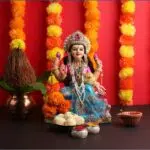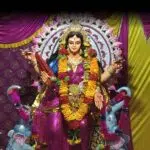Laxmi Puja is celebrated on the 15th day of the Kartik month of the Hindu calendar, which usually falls between mid-October and mid-November of the Gregorian calendar (our usual calendar). This year, it takes place on October 20. ‘Laxmi’ is the Hindu goddess of wealth and prosperity, and ‘Puja’ means the act of worship. So, if you have not connected the dots already, Laxmi Puja marks the occasion when the goddess of luxury is worshiped. To welcome the goddess into homes, people clean and decorate their houses and light lamps around the house to guide Lady Luck inside, and they offer their prayers to appease her and garner her blessings.
History of Laxmi Puja
In mythology, there are several stories about the origin of this day. Let’s shine light upon a few of them. The first one is about a mighty king and his wife, who is believed to be the reincarnation of goddess Laxmi. Rama was exiled from his rightful kingdom. Sita, his wife, and Lakshman, his brother, followed him into the 14-year-long exile to a forest. When they returned, the people of the kingdom illuminated their homes with lamps to welcome their king back.
According to another ancient story, the goddess Laxmi appeared from the churning of the ocean. Yup, you read that right, the ocean was churned! A big mountain was draped with a powerful snake; demons held one end of the snake and gods took the other. The churning began as they tugged at one end at a time. Many things popped up in the process, including goddess Laxmi, an elixir of immortality, the most potent poison, etc.
Now, the puja ceremony feels a little like Christmas. Houses are decorated with oil lamps, candles, and fairy lights. Rangolis are made at the entrance of the house (similar to decorating a Christmas tree). Expensive gifts, preferably gold and silver, are bought on this day, and family and friends visit each other. Kids also visit neighborhoods in small groups to sing songs, much like Christmas carols.
Laxmi Puja timeline
On January 10, Lord Rama is born.
Most scholars believe that the first hints of Hinduism appeared during the Indus Valley Civilization; Hinduism has 300 million gods and goddesses, with Laxmi being one of them.
Evidence of idol worship is also found in the Indus Valley, and Laxmi Puja is a form of idol worship.
Valmiki writes one of the most epic poems about Rama, the mighty king, between 500 B.C. and 100 B.C.
Laxmi Puja FAQs
What time is Laxmi Puja today in Nepal?
The dates and times of Laxmi Puja vary every year. You can learn the details from local priests or temples.
Why do Nepalis celebrate Tihar?
On each day of Tihar, an animal that contributes to the community is worshiped. It aims to thank mother nature for its gifts (in the form of animals) that help the community.
What is Diwali called in Nepal?
Diwali is celebrated in the neighboring subcontinent of India, and it is similar to Laxmi Puja in Nepal.
Laxmi Puja Activities
Make a rangoli
Rangoli is a colorful geometric pattern made at the entrance of the house using powdered colors and flowers. It can be a therapeutic experience if done right.
Illuminate the light within
Don’t just clean your house but get rid of regressive beliefs and limiting habits. As you light lamps around your house, also fill your soul with good vibes.
Pray to the goddess of prosperity
Wear new clothes (the brighter, the better) and visit your nearest temple of the goddess Laxmi with offerings such as fruits and sweets. Pray and give thanks to Laxmi for the goodness in your life.
5 Interesting Facts About Laxmi Puja
It is part of a national festival
Laxmi Puja is the third day of the five-day-long Hindu festival of Tihar celebrated in Nepal.
It shares the day with Gai Tihar
Gai Tihar is also celebrated on the third day of the Tihar festival to give gratitude to the cows; the ceremonies of Laxmi Puja usually begin in the evening, while the Gai Tihar ritual takes place during the day.
Laxmi’s footprints
People draw small footprints as part of the rangoli to guide the goddess Laxmi to the Puja bench in their homes and to her place in the temple.
Everyone wants blessings
Businesses and shops also celebrate Laxmi Puja to seek the blessings of the goddess of prosperity.
The festival is celebrated with carols
Small children sign traditional carols like Bhailo and Deusi, and in turn, they receive blessings in the form of money, fruits, and sweets from the neighboring houses.
Why We Love Laxmi Puja
Everyone wears their best clothes
On this day, everyone wears new clothes. Bright-colored clothes, especially those in red and yellow, are considered more auspicious than others.
Special treats are offered
Today, local delicacies are prepared. This includes both sweet and savory dishes, so everyone is in for a tasty treat.
It’s a long holiday
In Nepal, Tihar is a five-day-long non-working holiday for most. Everyone sure loves and enjoys a long, delightful holiday full of festivals and colors.
Laxmi Puja dates
| Year | Date | Day |
|---|---|---|
| 2024 | November 1 | Friday |
| 2025 | October 20 | Monday |
| 2026 | November 8 | Sunday |



























